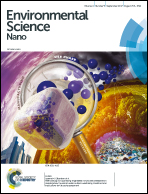Fabrication of a phosphorylated graphene oxide–chitosan composite for highly effective and selective capture of U(vi)†‡
Abstract
Uranium is not only a strategic resource for nuclear power but also a highly toxic contaminant in the environment. Although a series of traditional capturing materials including zeolites, metal–organic frameworks, mesoporous silica, and carbon-based nanomaterials have been investigated and developed, the combined advantages of decent stability, ultrafast removal kinetics, high sorption capacity, great selectivity, and potential recyclability have yet to be integrated into a single material. Herein, a new synthesis strategy was developed to synthesize a novel phosphorylated graphene oxide (GO)–chitosan (CS) composite (denoted as GO–CS–P) for U(VI) removal. The crosslinking of GO with CS and the subsequent phosphorylation of the GO–CS composite were demonstrated by scanning electron microscopy (SEM), powder X-ray diffraction (PXRD), Fourier transform infrared spectroscopy (FTIR), zeta potential measurement, thermogravimetric (TG) analysis, and scanning transmission electron microscopy (STEM). Batch experiments and spectroscopic analysis were performed to explore the removal performance and mechanism of GO–CS–P towards U(VI). The results showed that the uptake of U(VI) was ultrafast as the sorption equilibrium could be reached within 15 min. The maximum sorption capacity of U(VI) at pH 5.0 and 293 K was calculated to be 779.44 mg g−1, one of the highest values among the currently reported adsorbents. GO–CS–P also exhibited an excellent selectivity for capturing U(VI) from a mixture containing multiple competing metal ions. According to the desorption experiments, FTIR, X-ray absorption spectroscopy (XAS) and X-ray photoelectron spectroscopy (XPS) analysis, the highly efficient immobilization of U(VI) in GO–CS–P was predominantly controlled by inner-sphere surface complexation with a minor contribution of surface reduction. The experimental findings demonstrated the feasibility of using GO–CS–P for used nuclear fuel partition and uranium-bearing wastewater remediation.



 Please wait while we load your content...
Please wait while we load your content...